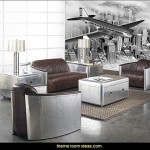Small Living Room Decor Tips: Maximizing Space and Style
Decorating a small living room presents unique challenges. The limited square footage necessitates careful planning and creative solutions to create a functional and aesthetically pleasing space. Effective design leverages visual tricks, strategic furniture placement, and thoughtful material choices to maximize the room’s perceived size and overall comfort. This article provides practical tips for transforming a small living room into a stylish and inviting haven.
Embrace Multifunctional Furniture
The most crucial element in small space design is optimizing every piece of furniture. Multifunctional furniture serves this purpose exceptionally well. Consider a sofa bed or a sleeper sofa for accommodating guests without dedicating an entire room to a guest bed. Ottomans can serve as coffee tables and provide hidden storage for blankets, throws, or even board games. Storage ottomans offer a double benefit, providing both seating and storage solutions. Similarly, a dining table with drop-leaf sides offers flexibility, expanding for larger gatherings and shrinking for everyday use. Choosing furniture with built-in features, like drawers in a coffee table or a bookcase, is paramount to keeping the space organized and clutter-free. Investing in these versatile pieces not only saves space but also streamlines the overall aesthetic, contributing to a cleaner, less cluttered look.
Light is Key: Strategic Lighting Choices
Lighting plays a critical role in influencing the perception of space. A well-lit room feels larger and more inviting. Natural light is always the preferred option, so maximizing access to natural light is a primary goal. Avoid heavy, dark curtains that block sunlight. Instead, opt for light-filtering or sheer curtains that allow light to permeate while maintaining privacy. Layering artificial light creates a more flexible and dynamic atmosphere. Incorporate a combination of ambient, task, and accent lighting. Ambient lighting, provided by overhead fixtures or strategically placed floor lamps, provides general illumination. Task lighting, such as a reading lamp next to a chair, focuses light where it's needed. Accent lighting, such as wall sconces or recessed lighting, highlights architectural features or decorative elements, creating visual interest and depth. Using dimmer switches allows for adjusting the intensity of the light to suit different moods and times of day. Light-colored lampshades also reflect light more effectively than dark ones.
Color Palette and Visual Tricks
Color significantly impacts the perception of space. Light and neutral colors, such as white, cream, pale grey, and pastels, generally make a room appear larger and airier. These colors reflect light, visually expanding the space. Painting walls, ceilings, and trim in the same or similar light colors can blur the boundaries and create a sense of continuity, making the room feel larger. Darker colors can be used as accent colors on a single wall or in the form of decorative elements, but should be used sparingly in a small living room. Vertical stripes on a wall can create the illusion of height, while horizontal stripes can make a room feel wider. Mirrors are powerful tools for enhancing the sense of space. Placing a large mirror opposite a window reflects natural light, creating the illusion of another window and doubling the perceived size of the room. Consider using mirrors to reflect artwork or a visually appealing part of the room to further enhance the aesthetic appeal. Consider using consistent colors in art pieces and rugs to visually tie the room together.
Furniture Placement and Flow
Thoughtful furniture placement is vital in a small living room. Avoid overcrowding the room. Select furniture pieces that are appropriately scaled to the space. Oversized furniture can overwhelm the room and make it feel smaller. Instead, choose smaller sofas, loveseats, or even a pair of armchairs rather than a large sectional sofa. Consider the traffic flow within the room. Ensure pathways are clear and easy to navigate. Arrange furniture to create conversational areas, such as placing seating around a coffee table or facing a fireplace or television. Avoid blocking windows or doorways with furniture. Floating shelves or wall-mounted cabinets provide storage without taking up valuable floor space, maximizing the available area. Consider placing a sofa against a wall to maximize floor space in the room.
Maximize Storage and Minimize Clutter
Clutter is the enemy of small spaces. A cluttered room feels smaller and more chaotic. Prioritize storage solutions to keep the living room organized and tidy. Incorporate hidden storage wherever possible. Consider storage ottomans, coffee tables with drawers, and bookshelves with closed cabinets to conceal items. Utilize vertical space by installing tall bookshelves or cabinets to make use of wall space. Declutter regularly, getting rid of items that are not used or needed. Implement the "one in, one out" rule; for every new item brought into the room, get rid of an existing item. Incorporate baskets or decorative containers to organize smaller items like magazines, remote controls, and blankets. Maintaining a clean and organized space is critical to the overall aesthetic and the comfortable living.
Accessorize Thoughtfully
Accessories play a crucial role in adding personality and style to a small living room. However, it is essential to be mindful of the scale and quantity of accessories. Choose a few well-chosen pieces rather than overwhelming the space with numerous objects. Opt for accessories that serve a dual purpose, such as decorative trays for organizing items on a coffee table. Use the walls for displaying art. A gallery wall of smaller framed prints or a single large piece of artwork can add visual interest without taking up valuable floor space. Select accessories that complement the color palette and overall style of the room. Consider textiles such as throw pillows, blankets, and rugs to add warmth and texture to the space. Choose patterns and colors that enhance the room's aesthetic and add visual interest. Layering textures, such as a plush rug, a woven basket, and a velvet throw pillow, will add complexity and character to your space.

10 Stunning Small Living Room Ideas To Maximize Space

How To Decorate A Small Living Room Forbes Home
:max_bytes(150000):strip_icc()/241791572_212003384294928_1925123565378044744_n-3dceead11099472ca283f51eea10a0f3.jpg?strip=all)
52 Small Living Room Ideas To Maximize Space And Style
:max_bytes(150000):strip_icc()/154844841_1913837928767303_4703053855314656226_n-7776f09f3d67417caf5a7bd062c1acd1.jpg?strip=all)
52 Small Living Room Ideas To Maximize Space And Style

8 Decorating Ideas For Styling A Small Living Room Ruggable Blog

Small Living Room Decorating Ideas 5 Tips To Open Up Your Space

Small Living Room Decorating Ideas Designcafe

15 Best Small Living Room Ideas How To Decorate A

15 Small Living Room Design Ideas You Ll Want To Steal

44 Best Small Living Room Ideas How To Decorate A
Related Posts







